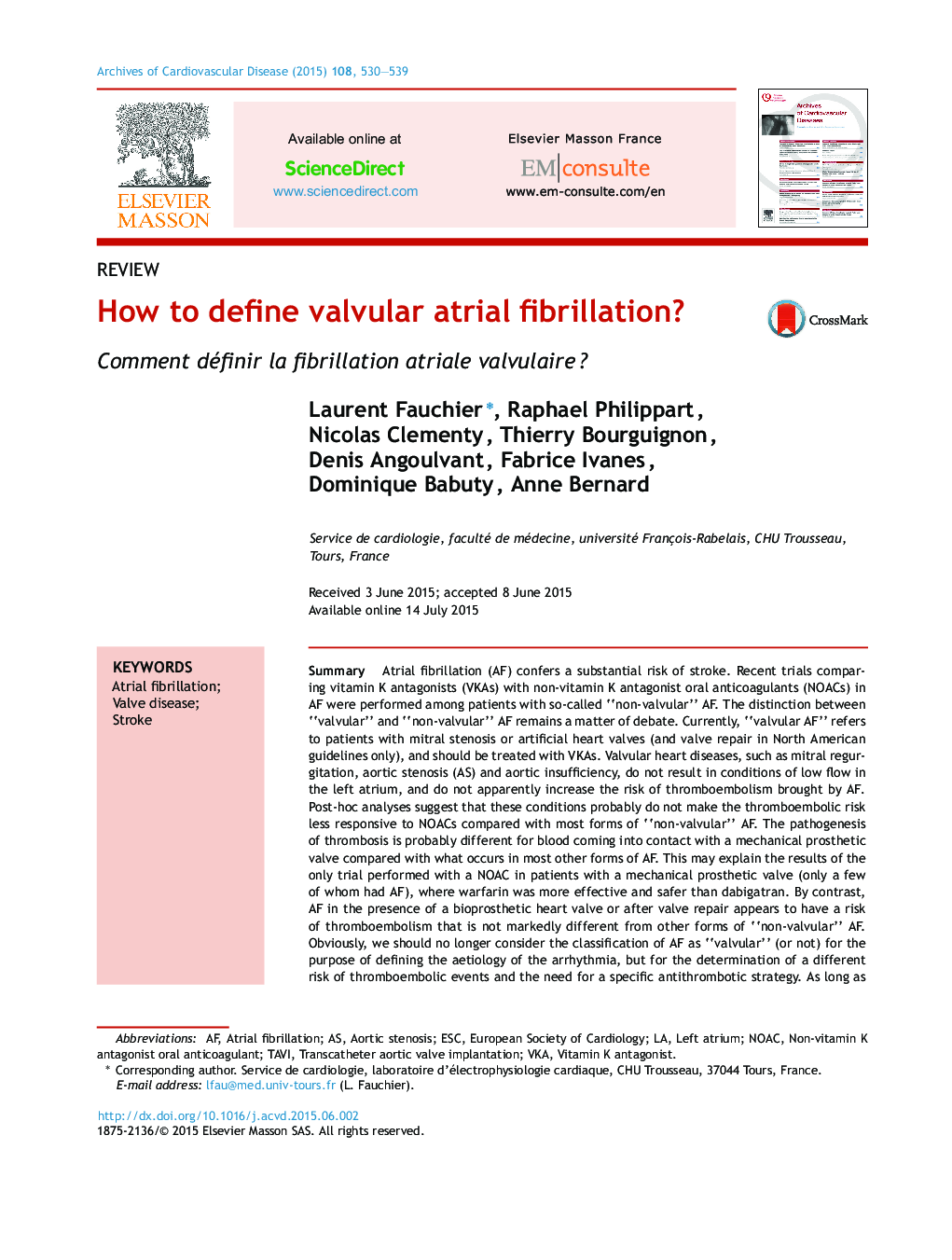| کد مقاله | کد نشریه | سال انتشار | مقاله انگلیسی | نسخه تمام متن |
|---|---|---|---|---|
| 2888758 | 1574341 | 2015 | 10 صفحه PDF | دانلود رایگان |
SummaryAtrial fibrillation (AF) confers a substantial risk of stroke. Recent trials comparing vitamin K antagonists (VKAs) with non-vitamin K antagonist oral anticoagulants (NOACs) in AF were performed among patients with so-called “non-valvular” AF. The distinction between “valvular” and “non-valvular” AF remains a matter of debate. Currently, “valvular AF” refers to patients with mitral stenosis or artificial heart valves (and valve repair in North American guidelines only), and should be treated with VKAs. Valvular heart diseases, such as mitral regurgitation, aortic stenosis (AS) and aortic insufficiency, do not result in conditions of low flow in the left atrium, and do not apparently increase the risk of thromboembolism brought by AF. Post-hoc analyses suggest that these conditions probably do not make the thromboembolic risk less responsive to NOACs compared with most forms of “non-valvular” AF. The pathogenesis of thrombosis is probably different for blood coming into contact with a mechanical prosthetic valve compared with what occurs in most other forms of AF. This may explain the results of the only trial performed with a NOAC in patients with a mechanical prosthetic valve (only a few of whom had AF), where warfarin was more effective and safer than dabigatran. By contrast, AF in the presence of a bioprosthetic heart valve or after valve repair appears to have a risk of thromboembolism that is not markedly different from other forms of “non-valvular” AF. Obviously, we should no longer consider the classification of AF as “valvular” (or not) for the purpose of defining the aetiology of the arrhythmia, but for the determination of a different risk of thromboembolic events and the need for a specific antithrombotic strategy. As long as there is no better new term or widely accepted definition, “valvular AF” refers to patients with mitral stenosis or artificial heart valves. Patients with “non-valvular AF” may have other types of valvular heart disease. One should emphasize that “non-valvular AF” does not exclude patients with some types of valvular heart disease from therapy with NOACs.
RésuméLa fibrillation atriale (FA) est associée à un risque d’accident vasculaire cérébral. Les essais récents comparant antivitamines K (AVK) et anticoagulants oraux directs non-AVK (NACO) dans la FA ont été réalisés chez des patients avec FA, dite « non valvulaire ». La différence entre FA « valvulaire » et « non valvulaire » reste néanmoins sujet à controverses. Actuellement, la FA « valvulaire » fait référence aux patients avec rétrécissement mitral ou prothèse valvulaire cardiaque (ainsi qu’aux plasties mitrales dans les recommandations nord américaine) et nécessite un traitement par AVK. Les valvulopathies, telles que l’insuffisance mitrale, le rétrécissement aortique ou l’insuffisance aortique ne sont pas associées à un bas débit dans l’oreillette gauche et semblent ne pas augmenter le risque thromboembolique lié à la FA. Des analyses post-hoc suggèrent que le bénéfice des NACO dans ces pathologies n’est pas différent de celui constaté pour les autres patients avec FA « non valvulaire ». Le processus de thrombogénicité est probablement différent des autres formes de FA lorsque le sang entre en contact avec du matériel de prothèse valvulaire mécanique. Ceci pourrait expliquer les résultats négatifs du seul essai réalisé à ce jour avec un NACO chez des patients avec prothèses mécaniques (dont seulement une minorité avaient de la FA) et où la warfarine à été plus efficace et plus sûre que le dabigatran. En revanche, la FA chez des patients avec une bioprothèse ou une plastie valvulaire semble associée à un risque thromboembolique assez similaire à celui attendu pour une FA « non valvulaire ». Manifestement, il ne faut plus envisager la classification d’une FA comme « valvulaire » (ou « non valvulaire ») pour définir l’étiologie de l’arythmie, mais dans le but de déterminer un risque différent d’évènements thromboemboliques et pour établir un traitement antithrombotique spécifique. Tant qu’il n’y aura pas de meilleur terme ou de nouvelle définition largement acceptée, la FA « valvulaire » fait référence aux patients avec rétrécissement mitral ou avec prothèse valvulaire (mécanique ou biologique). Les patients avec FA « non valvulaire » peuvent avoir d’autres types de valvulopathies. Il faut donc insister sur le fait que la définition de FA « non valvulaire » n’exclut pas certains patients avec valvulopathies des possibilités de traitement par NACO.
Journal: Archives of Cardiovascular Diseases - Volume 108, Issue 10, October 2015, Pages 530–539
